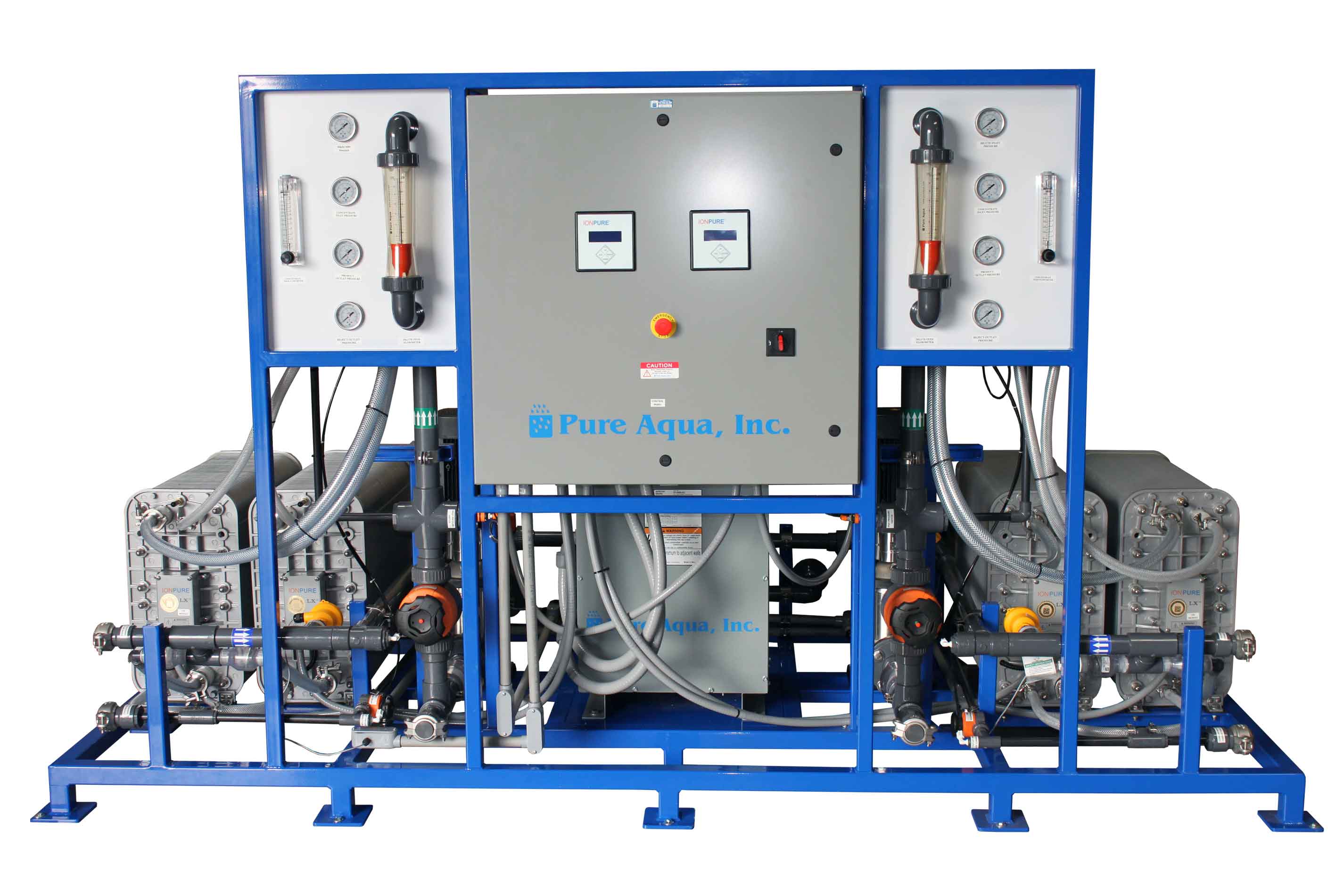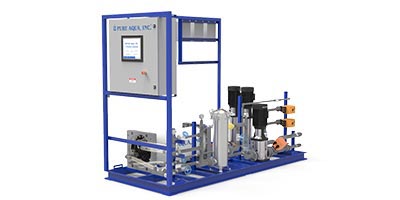EDI System In Water Treatment
Electrodeionization works in applying functional currents to eradicate ionized substances from water bodies, while simultaneously regrowing the ion exchange media. An EDI water system is usually applied after the usage of a reverse osmosis system or even a double pass ro system.
EDI water treatment help to guarantee that every part of the system will perform perfectly together. What results is an extremely purified solution that meets all of your requirements.
- Reduced chemical use
- Lower capital costs
- Compact design (saves space)
- 环境友好型
- Minimal maintenance
- 非常一致的操作
Service Flow Rates:
2to 220 GPM
(0.5 to 50 M³/hr)
- 无化学再生
- 小型紧凑模块
- 产生高达18兆欧厘米的水
Pure Aqua has over 20 years of experience as a global supplier在生产电去离子系统更高的纯度和支持跨多个行业的前沿解决方案在水处理。可靠性、高质量和无需化学再生使我们的EDI系统在市场上非常理想。雷电竞app合法吗雷电竞网页版
EDI系统消除电离和得物种from water using electrically active media and electrical potential (DC power) to affect ion transport. By using this type of purification technology, caustic and acidic types of chemicals are not required. The water which has been treated by RO-EDI has typically exceeded customer’s high-purity standards.
Electrodeionization system is a continuous electro-chemical process of water deionization where ion specific membranes, mixed bed resin and a DC voltage across them, replace the standard hazardous acid-caustic chemical regeneration process.

在EDI的最新技术中,由于许多原因,模块必须用RO进行预处理。然而,软化法和一次反渗透法和二次反渗透法作为预处理的优缺点是什么?
ManyEDI水系统in water treatment using Pure Aqua EDI technology perform very well with 1-pass RO. It is easy to achieve 17+ Megaohm with 1-pass RO. Most USP WFI and purified water systems easily meet requirements with 1-pass RO. As a basic knowledge in the water treatment industry, softening with 1-pass RO system is less expensive and less complex than a 2-pass RO system.
Two pass RO followed by EDI gives the following advantages, and is often used for power plants or pharmaceutical applications.
-
Lower conductivity = higher EDI quality
-
Lower CO 2 = higher silica removal
-
ppb级污染物意味着很少进行EDI清洗
-
Higher rated flows for EDI
单程RO system使用膜脱气器可提高EDI性能。膜脱气器可以减少二氧化碳,从而提高EDI的性能,降低结垢的可能性,并有助于通过EDI机去除SiO2。
In summary, EDI water systems have many options:
- Softener followed by RO followed by EDI modules
- Softener followed by RO followed by membrane degasser followed by EDI modules
- RO,然后是苛性碱加药,然后是RO,然后是EDI模块
It is difficult to meet the feed specification to the EDI water treatment plants without pH adjustment and/or membrane degasser. Decreasing the CO2 before the electrodeionization system will decrease the load (lower amps) and improve the product quality. Pure Aqua installed a membrane degasser on many EDI skids for CO2 removal/reduction. The membrane degasser replaced the proposed design of a conventional forced air degasser (tower). It was more cost efficient, compact and decreases installation time.
什么是电去离子?
Electrodeionization is a green solution used to remove ions from water with an electrically active media, without the use of chemicals. This process creates ultra pure water through combining ion exchange water filters with electrical potential (DC power). Electric potential regenerates resin with less cost, since it only requires electricity, while conventional离子交换水处理系统需要大型船只,酸/碱注射系统, and etc. EDI water treatment is also useful in cleaning RO permeate.
How does electrodeionization work?
Electrodeionization is designed to polish the permeate once the water has already went through a水处理system, such as reverse osmosis. This system utilizes low energy consumption and disposes of the need for costly and unsafe chemicals used in conventional ion exchange water filters. Such factors make operation expenses much lower, and helps水处理companiesmeet their环境保护quotas.
EDI系统清除二氧化碳有困难吗?
与反渗透系统不同,EDI水处理能够去除给水中的CO2浓度。这一点很重要,因为二氧化碳在水中似乎是离子化的,这使得它的浓度无法通过电导率测量来测量。此外,由于反渗透系统无法消除二氧化碳,这就严重依赖EDI水系统来实现。
 ENGLISHarrow_drop_down
ENGLISHarrow_drop_down ESPAÑOL
ESPAÑOL العربية
العربية PORTUGUÉS
PORTUGUÉS 弗兰Ç人工智能
弗兰Ç人工智能

